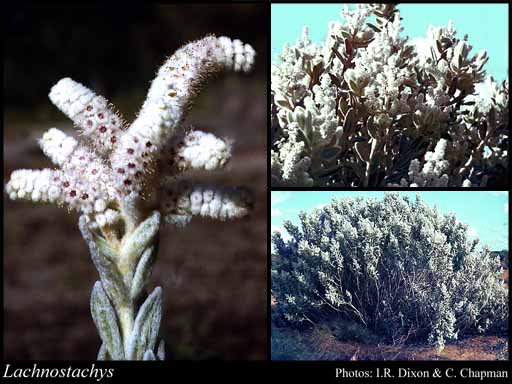- Reference
- Hooker's Icon.Pl. pt. 414. (1841)
- Name Status
- Current

Scientific Description
Common name. Lambs Tails. Family Lamiaceae.
Sometimes included in Chloanthaceae, Verbenaceae.
Habit and leaf form. Shrubs; evergreen; without essential oils; not resinous. ‘Normal’ plants to switch-plants (somewhat switch-plant-like, owing to sparse leaves and broom-like habit). Leaves well developed, or much reduced. Plants unarmed. Leaves cauline. Young stems cylindrical. Stem internodes solid (woody; stem clothed with a dense and thick covering of branched woolly tomentum). To 0.3–1.5 m high. Leptocaul. Leaves small to medium-sized; not fasciculate; opposite; decussate; decurrent on the stems (distinctly), or not decurrent on the stems; ‘herbaceous’ (rugose to sub-coriaceous when ageing); imbricate, or not imbricate; sessile; aromatic, or without marked odour; simple; epulvinate. Leaf blades entire; rolled (recurved along margins), or flat (rarely); linear, or lanceolate, or oblong, or ovate; ovate, or oblong to ovate, or oblong, or elliptic to oblong (narrowly), or orbicular (sub-), or linear (narrow); 1 -nerved; pinnately veined; cross-venulate. Mature leaf blades adaxially woolly (sometimes rugose and glabrescent in old leaves); abaxially woolly. Leaves without stipules. Leaf blade margins entire; rarely flat, or revolute. Leaves without a persistent basal meristem. Leaf anatomy. Hairs present; glandular hairs absent; complex hairs present. Complex hairs stellate. Stem anatomy. Secondary thickening anomalous; via concentric cambia.
Reproductive type, pollination. Fertile flowers hermaphrodite. Unisexual flowers absent. Plants hermaphrodite. Plants homostylous. Entomophilous.
Inflorescence and flower features. Flowers aggregated in ‘inflorescences’. Inflorescence many-flowered. Flowers not in pairs subtended by a common bract; in panicles. Inflorescences terminal and axillary; axillary and terminal panicles with flowers either somewhat compactly arranged into elongated cylindrical spikes or forming more or less lax corymbose or pyramidal panicles. The fruiting inflorescence not conelike. Flowers sessile to subsessile; bracteate; bracteolate; small; regular; 5–8(–9) merous; cyclic; tetracyclic. Free hypanthium absent. Hypogynous disk absent. Perianth with distinct calyx and corolla; 10; 2 -whorled; isomerous. Perianth members entire. Calyx present; 5–8(–9); 1 -whorled; gamosepalous; shortly blunt-lobed; exceeded by the corolla to more or less equalling the corolla; more or less campanulate; regular; non-fleshy; persistent; non-accrescent. Calyx lobes ovate, or triangular (broadly), or triangular to ovate (more or less). Corolla present; 5–8(–9); 1 -whorled; gamopetalous; entire to lobed; when not entire, lobulate; imbricate; campanulate; regular; glabrous abaxially; hairy adaxially (villous-tomentose); plain; violet (or mauve), or purple, or purple to violet. Corolla members entire. Androecium present. Androecial members definite in number. Androecium 5–8 (rarely more). Androecial members adnate; all equal; free of one another; 1 -whorled. Androecium exclusively of fertile stamens. Stamens 5–8. Staminal insertion in the throat of the corolla tube. Stamens becoming exserted; all more or less similar in shape; reduced in number relative to the adjacent perianth; oppositisepalous (inserted on the margin (rim) of the corolla tube). Filaments glabrous; filiform. Anthers dorsifixed; dehiscing via longitudinal slits; bilocular (lobes oblong, free and divergent in the lower halves). Gynoecium 2 carpelled. The pistil 2 celled, or 4 celled. Carpels reduced in number relative to the perianth. Gynoecium syncarpous; synstylovarious (styles free in upper part); superior. Ovary plurilocular; 2 locular, or 4 locular (rarely, ostensibly, via false septa). Locules secondarily divided by ‘false septa’, or without ‘false septa’. Gynoecium median. Ovary summit hairy, the hairs not confined to radiating bands (and sometimes glandular at the top). Gynoecium stylate. Styles 1; simple (long, slender); attenuate from the ovary; apical; much longer than the ovary at anthesis; becoming exserted; hairy, or hairless (often just in top half). Stigmas 2; 1 - lobed (very minutely notched). Placentation axile. Ovules 2 per locule, or 1 per locule (rarely, via false septation); sessile (attached ‘laterally’ below the apex); non-arillate; hemianatropous.
Fruit and seed features. Fruit non-fleshy; indehiscent; a nut; 4 celled; 4 locular. Dispersal unit the seed. Fruit 1 seeded (usually). Seeds endospermic. Embryo straight.
Special features. Perianth (calyx) glabrous outside. Calyx limb 5–8(–9) lobed. Corolla tube straight.
Geography, cytology, number of species. Native of Australia. Endemic to Australia. Australian states and territories: Western Australia. South-West Botanical Province and Eremaean Botanical Province. A genus of 6 species; 6 species in Western Australia; 6 endemic to Western Australia.
Etymology. From the Greek for "soft wool" and "ear of corn, flower-spike".